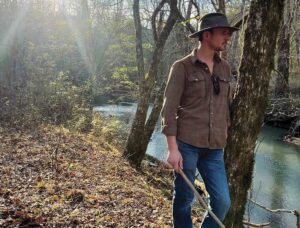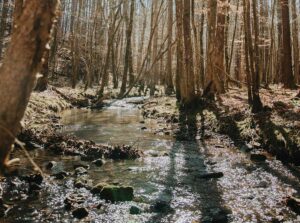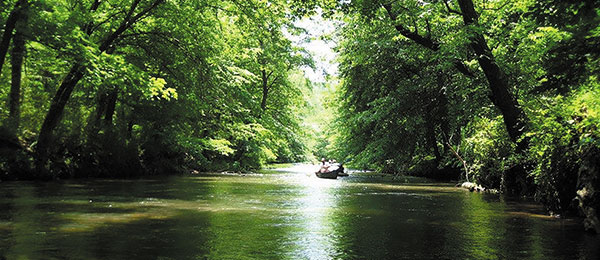
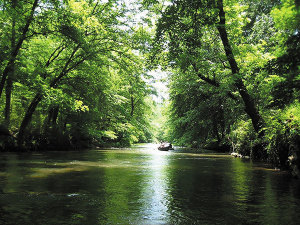 Big Canoe Creek & Chandler Mountain Orchard
Big Canoe Creek & Chandler Mountain Orchard
Story by Carol Pappas
Submitted Photos
It’s more than just a job for Wendy Jackson, executive director of the Freshwater Land Trust. When a piece of land, a creek or a stream can be preserved, it’s about the future.
It’s about her grandchildren and their grandchildren. It’s about partnerships, where public and private entities come together to preserve the past for the future. And it’s about sharing those protected treasures for generations to come.
Few know that better than Doug Morrison, who heads up the Friends of Big Canoe Creek in Springville. Since 2009, he and his group have been working with Freshwater Land Trust, St. Clair County Commission and City of Springville to protect this pristine area as a nature preserve in the state’s Forever Wild program.
Atop Chandler Mountain, Jerry and Janice Lanning know the value of the work, too. Their acreage is being preserved as an orchard growing a blight-resistant American Chestnut Tree, one of only two such orchards in Alabama and the state’s base of operations.
“It looks like a go,” Jackson said of the Big Canoe Creek Nature Preserve, which is nearing an expected real estate closing in coming months. Forever Wild, a state program that buys land to protect and preserve it, has made an offer, and the landowner has accepted.
“Mayor (William “Butch”) Isley and the City Council of Springville, the St. Clair County Commission and the Friends of Big Canoe Creek really stepped up to the plate and did what others around the state have been trying to do,” Jackson said. Their success will mean 327 acres of land fronting Big Canoe Creek near Homestead Hollow can be preserved for the future and shared for the public to enjoy.
“We are so excited. It really is testament to a lot of leadership in St. Clair County. A lot of other counties haven’t seen this success,” she said. In addition to the obvious win on the environmental side, Jackson called it a “huge win on the economic front” because it is expected to lure tourism dollars to the county.
“This is a great example of how we work,” she said. “We’re not an advocacy group. We don’t file lawsuits. We believe hunters and anglers are some of the greatest conservationists, helping to preserve places that matter.”
Based in Birmingham, FWLT does its work in an eight-county area through public and private partnerships and a tool called a conservation easement. “It helps keep family lands in family hands,” she explained. Landowners can continue to farm or manage a forest while preserving it for the future. They can protect the land from future development and “preserve a way of life they care about.”
There are estate planning tools through conservation easements that can reduce estate taxes, but many people don’t know of their existence because the act that created it was not passed until 1996.
“We want to make sure farms stay farms,” she said. “In 50 years, we will need to feed two times the people we feed now. The average age of a farmer today is 60, and we’re losing farms every year.”
 And they want to ensure that lands rich in biodiversity like Big Canoe Creek are protected and preserved. “Doug Morrison has really been a hero in this along with the city and county. He has really been a champion and stayed on it.”
And they want to ensure that lands rich in biodiversity like Big Canoe Creek are protected and preserved. “Doug Morrison has really been a hero in this along with the city and county. He has really been a champion and stayed on it.”
“We are thrilled that this project is moving forward,” Morrison said. “The Friends of Big Canoe Creek originally nominated this parcel in July 2009. We were later approached by an adjoining land owner and nominated a second tract in April 2010. In May of 2010, we partnered with the Freshwater Land Trust and conducted a Bioblitz on the nominated parcels.
The Bioblitz was an intense 24-hour biological survey in an attempt to record all the living species in the area, land and water.
“We had groups of scientists, biologists, naturalists and volunteers participating. Some of the groups attending were professors and students from Birmingham Southern and Samford, a biologist from the Nature Conservancy, folks from Alabama Rivers Alliance, the Black Warrior Riverkeeper, photographers from the Conservation Photographers of Alabama, and of course, many volunteers from the Friends of Big Canoe Creek. After the first tract is acquired we are hopeful the second tract can be added.”
When the property gets its official designation, it will become a nature preserve. Its nomination letter describes it as “hilly, forested terrain and aquatic and riparian habitat in and near Big Canoe Creek, including the drainage of a significant tributary of the creek.”
It has “abundant creek-side scenery and wildlife habitat. High points on the property afford views of the uppermost section of the Big Canoe Creek watershed, including beautiful rural Canoe Creek valley and the opposing ridges of Pine and Blount Mountains. The site is suitable for hiking, bird watching, paddling, mountain biking, horseback riding and a variety of other outdoor activities.”
“This endeavor is truly a community driven project,” Morrison said.
American Chestnut making comeback
Meanwhile, another environmental project is taking root in St. Clair County on Chandler Mountain, where the Lannings have donated land for an orchard to regenerate a blight-resistant American Chestnut Tree.
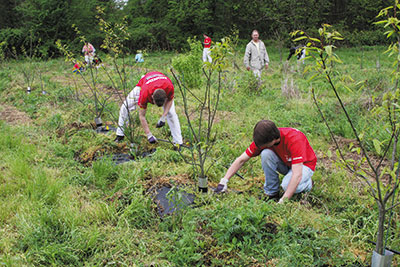 Originally known as the Redwoods of the East, these enormous trees — once found in Alabama and St. Clair County — became extinct because of a Japanese blight accidentally introduced in the United States in the early 1900s.
Originally known as the Redwoods of the East, these enormous trees — once found in Alabama and St. Clair County — became extinct because of a Japanese blight accidentally introduced in the United States in the early 1900s.
Once the blight spread, there was no stopping it. It wiped out these majestic trees, completely changing the landscape of the Eastern United States. “My mother remembered seeing them as a child,” Jackson said. After that, they were gone.
Working with the American Chestnut Foundation, timber companies and other groups, FWLT is involved in the St. Clair project, which is predicted to take decades to reach its goal of a blight-resistant tree.
“It’s a long-term proposition,” Jackson said. The tree is planted and at a certain age, the blight is introduced. If it survives, that tree is propagated. “It’s a multigenerational thing that will take decades for complete regeneration.”
And just as partnerships have worked well in the Big Canoe project, partnerships are playing a key role in this one, too, she said. Timber companies are helping with seedlings. A whole team of work volunteers from Honda Manufacturing of Alabama laid pipe for an irrigation system and planted another tier of trees to expand the orchard.
What is happening on top of that mountain is a valiant effort to bring back trees that the country’s founding fathers used to build furniture and split rail fences. They were trees that provided food to support an abundance of wildlife. It’s about the ecosystem, and it’s about timber for wood products — all interested parties working together to make something good happen.
But it’s more than that, Jackson said, adding a personal view of it. She knows it can’t come to fruition in her lifetime. “My goal is for my granddaughter to one day be able to walk under the shade of a Chestnut tree” — a simple pleasure she wants for her grandchildren and the generations that follow after.

















